Abstract
The material derivative concept of continuum mechanics and an adjoint variable method of design sensitivity analysis are used to relate variations in structural shape to measures of structural performance. A domain method of shape design sensitivity analysis is used to best utilize the basic character of the finite element method that gives accurate information not on the boundary but in the domain. Implementation of shape design sensitivity analysis using finite element computer codes is discussed. Recent numerical results are used to demonstrate accuracy that can be obtained using the method. Result of design sensitivity analysis is used to carry out design optimization of a built-up structure.
Research supported by Nasa-Langley Grant NAG-1-215.
Access this chapter
Tax calculation will be finalised at checkout
Purchases are for personal use only
Preview
Unable to display preview. Download preview PDF.
Similar content being viewed by others
References
Haftka, R.T. and Kamat, M.P., Elements of Structural Optimization, Martinus Nijhoff Publishers, Boston, 1985.
Haug, E.J., Choi, K.K. and Komkov, V., Design Sensitivity Analysis of Structural Systems, Academic Press, New York, N.Y., March, 1986.
Haftka, R.T. and Grandhi, R.V., “Structural Shape Optimization-Survey,” Computer Methods in Applied Mechanics and Engineering, to appear, 1986.
Botkin, M.E., “Shape Optimization of Plate and Shell Structures,” AIAA J., Vol. 20, No. 2, 1982, pp. 268–273.
Francavilla, A., Ramakrishnan, C.V. and Zienkiewicz, O.C., “Optimization of Shape to Minimize Stress Concentration”, J. of Strain Analysis, Vol. 10, No. 2, 1975, pp. 63–70.
Braibant, V. and Fleury, C., “Shape Optimal Design Using B-Splines, ” Computer Methods in Applied Mechanics and Engineering, Vol. 44, 1984, pp. 247–267.
Dems, K. and Mroz, Z., “Variational Approach by Means of Adjoint Systems to Structural Optimization and Sensitivity Analysis — II Structural Shape Variation,” Int. J. Solids and Structures, Vol. 20, No. 6, 1984, pp. 527–552.
Cea, J. “Problems of Shape Optimal Design,” Optimization of Distributed Parameter Structures, E.J. Haug and J. Cea (Eds.), Sijthoff & Noordhoff, Alpen ann den Rijn, The Netherlands, 1981, pp. 1005–1048.
Choi, K.K. and Haug, E.J., “Shape Design Sensitivity Analysis of Elastic Structures,” J. of Struct. Mechanics, Vol. 11, No. 2, 1983, pp. 231–269.
Choi, K.K., “Shape Design Sensitivity Analysis of Displacement and Stress Constraints,” J. of Struct. Mechanics, Vol. 13, No. 1, 1985, pp. 27–41.
Haug, E.J., Choi, K.K., Hou, J.W. and Yoo, Y.M., “A Variational Method for Shape Optimal Design of Elastic Structures,” New Directions in Optimum Structural Design, E. Atrek, R.H. Gallagher, K.M. Ragsdell and O.C. Zienkiewicz ( Eds. ), John Wiley and Sons, Ltd., 1984, pp. 105–137.
Na, M.S., Kikuchi, N. and Taylor, J.E., “Shape Optimization for Elastic Torsion Bars,” Optimization Methods in Structural Design, H. Eschenauer and N. Olhoff (Eds.), Bibliographisches Institut, Zurich, Germany, 1983, pp. 216–223.
Babuska, I. and Aziz, A.K., “Survey Lectures on the Mathematical Foundations of the Finite Element Method,” The Mathematical Foundations of the Finite Element Method with Applications to Partial Differential Equations, Academic Press, 1972, pp. 1–359.
Choi, K.K. and Seong, H.G., “A Domain Method for Shape Design Sensitivity Analysis of Built-Up Structures,” Computer Methods in Applied Mechanics and Engineering, to appear, 1986.
Seong, H.G. and Choi, K.K., “Boundary Layer Approach to Shape Design Sensitivity Analysis,” J. of Struct. Mechanics, to appear, 1986.
Choi, K.K. and Yao, T.M., “3-D Modeling and Automatic Regridding in Shape Design Sensitivity Analysis,” NASA Symposium: Sensitivity Analysis in Engieering, NASA-Langley Research Center, Virginia, September 25–26, 1986.
Choi, K.K. and Seong, H.G., “Design Component Method for Sensitivity Analysis of Built-Up Structures,” J. of Struct. Mechanics, to appear, 1986.
Choi, K.K., Santos, J.L.T., and Frederick, M.C., “Implementation of Design Sensitivity Analysis with Existing Finite Element Codes,” ASME Journal of Mechanisms, Transmissions, and Automation in Design, 85-DET-77.
Zolesio, J-P., “The Material Derivative (or Speed) Method for Shape Optimization,” Optimization of distributed Parameter Structures, E.J. Haug and J. Cea (Eds.) Sijthoff & Noordhoff, Alphen ann den Rijn, The Netherlands, 1981, pp. 1089–1151.
Zolesio, J-P., “Gradient des coute Governes par des Problems de Neumann poses des Wuverts Anguleux en Optimization de Domain”, CRMA-Report 116, University of Montreal, Canada, 1982.
Choi, K.K. and Seong, H.G., “A Numerical Method for Shape Design Sensitivity Analysis and Optimization of Built-Up Structures,” The Optimum Shape: Automated Structural Design, (Eds. J.A. Bennett and M.E. Botkin ), Plenum Press, New York, 1986.
Dym, C. and Shames, I.H., Solid Mechanics-A Variational Approach, McGraw-Hill, 1973.
Rogers, D.F. and Adams, J.A., Mathematical Elements for Computer Graphics, McGraw-Hill, 1976.
DeSalvo, G.J. and Swanson, J.A., ANSYS Engineering Analysis System, Users Manual, Swanson Analysis System, Inc., P.O. Box 65, Houston, PA, Vols. I and I I, 1983.
Przemieniecki, J.S., Theory of Matrix Structural Analysis, McGraw- Hill, 1968.
Lam, H.L., Choi, K.K., and Haug, E.J., “A Sparse Matrix Finite Element Technique for Iterative Structure Optimization,” Computers and Structures, Vol. 16, No. 1–4, 1983, pp. 289–295.
Choi, K.K., Haug, E.J., Hou, J.W., and Sohoni, V.N., “Pshenichny’s Linearization Method for Mechanical System Optimization,” ASME Journal of Mechanisms, Transmissions, and Automation in Design, Vol. 105, No. 1, 1983, pp. 97–103.
Author information
Authors and Affiliations
Editor information
Editors and Affiliations
Rights and permissions
Copyright information
© 1987 Springer-Verlag Berlin Heidelberg
About this paper
Cite this paper
Choi, K.K. (1987). Shape Design Sensitivity Analysis and Optimal Design of Structural Systems. In: Mota Soares, C.A. (eds) Computer Aided Optimal Design: Structural and Mechanical Systems. NATO ASI Series, vol 27. Springer, Berlin, Heidelberg. https://doi.org/10.1007/978-3-642-83051-8_13
Download citation
DOI: https://doi.org/10.1007/978-3-642-83051-8_13
Publisher Name: Springer, Berlin, Heidelberg
Print ISBN: 978-3-642-83053-2
Online ISBN: 978-3-642-83051-8
eBook Packages: Springer Book Archive




